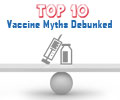Pandemic influenza vaccines produced for swine flu, and influenza virus were effective in preventing the disease and reducing hospitalizations.
Highlights
- Pandemic influenza vaccines were found to be 73 percent effective at preventing laboratory-confirmed influenza illness.
- The vaccines were shown to be less effective in //adults over 18 years than in children, and effectiveness was lowest in adults over 50 years of age.
Professor Van Tam said, "The 2009 swine flu pandemic was the first in human history when pandemic vaccines have been available worldwide. It's therefore really important to pull all of these data together and ask the question: did these vaccines really work?”
The vaccines produced against the swine flu pandemic in 2009 were very effective in both preventing influenza infection and reducing the chances of hospital admission due to flu. This is all very encouraging in case we encounter a future pandemic, perhaps one that is more severe.
Of course, we recognise that it took five to six months for pandemic vaccines to be ready in large quantities; this was a separate problem. However, if we can speed up vaccine production times, we would have a very effective strategy to reduce the impact of a future flu pandemic.
Vaccine For H1N1 Virus
The first cases were reported in the United States in March 2009 but the new virus spread rapidly to other countries and in June 2009 the WHO declared a pandemic caused by this strain, known as influenza A(H1N1)pdm09, or 'swine flu'.
Many individual studies have looked at how effective the available vaccines were at preventing illness and hospitalisation caused by the pandemic influenza strain but up until now no-one has summarised all the available data. This systematic review and meta-analysis is the most comprehensive summary and offers insight into the relative effectiveness of both adjuvanted and non-adjuvanted vaccines in different age groups.
First Review On Vaccines for Pandemic flu
The researchers found 38 studies published between June 2011 and April 2016 that measured the effectiveness of the inactivated pandemic influenza vaccines, covering a population of more than 7.6m people.
Overall, pandemic influenza vaccines were found to be 73 percent effective at preventing laboratory-confirmed influenza illness and 61 percent effective at preventing hospitalisation in the population as a whole.
However, when the vaccines' effectiveness was examined in different age groups, they were shown to be less effective in adults over 18 years than in children, and effectiveness was lowest in adults over 50 years of age.
Adjuvanted vaccines in particular were found to be more effective in children than in adults against laboratory confirmed illness (88 percent in children versus 40 percent in adults) and hospitalisation (86 percent in children versus 48 percent in adults).
Overall the inactivated pandemic influenza vaccines used in the 2009 pandemic were effective in preventing laboratory-confirmed illness and hospitalisation. Adjuvanted vaccines tended to be more effective than non-adjuvanted vaccines but only in children.
The lower effectiveness in older people may be due to them having pre-existing antibodies against A(H1N1)pdm09 from previous exposure to a similar virus, with corresponding lower incidence of the infection in this age group.
The results showed that pandemic influenza vaccines produced globally during the 2009-10 pandemic were largely effective in reducing illness and hospitalisation. The results from the study could be used to help public health officials to plan a more effective response to future pandemics, such as rolling out vaccines at a much earlier time and targeting specific types of vaccines at different age groups.
Reference
- Professor Jonathan Van Tam et al., Vaccines do work for pandemic flu, says study, Vaccine (2017) http://dx.doi.org/10.1016/j.vaccine.2017.02.05.
Source-Medindia














